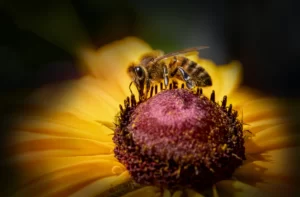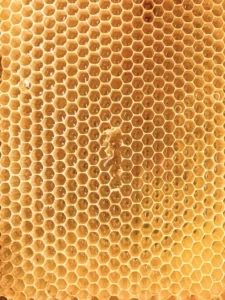Table of Contents
Seasonal allergies can be a real buzzkill, but what if there was a sweet solution to your sniffling and sneezing…down the honey aisle at your local farmers market? That’s right, local honey has been touted as a natural remedy for allergies for centuries – and for good reason. With its unique blend of pollen from the flowers in your area, consuming local honey is thought to help support immunity to allergens, providing relief from runny noses, sneezing, and so much more.
The Benefits of Local Honey for Allergies
When allergy season is upon us, unwanted symptoms such as sneezing, runny noses, and itchy eyes can make it hard to appreciate flowers and trees. Allergy shots are an answer, but they aren’t for everyone. A sweet, natural solution to help relieve these nagging allergy symptoms and help bolster our immune system health might just be buzzing outside of your window: honey.
We’re not just talking about any type of honey, though…we mean local honey, and to be even more precise, local raw honey. Rather than going to a big box grocery and picking up a national brand of honey that is mass-produced, for the maximum health benefits, you’ll want honey made by bees who gather nectar from the local flowers in your surrounding neighborhood–or even your own backyard (if you’re brave enough to venture into beekeeping, that is.)
How Local Honey Helps with Allergies
Raw honey from your home turf contains tiny amounts of localized pollen, which can help build immunity to seasonal allergies over time. This idea is based on the concept of immunotherapy (which is what you get from allergy shots), in which exposure to small amounts of an allergen can help reduce the body’s sensitivity to it over time.
You may still be thinking honey goes on your favorite foods, not in your medicine cabinet. However, when local honey is combined with an over-the-counter medicine, the results can be un-bee-lievable. In fact, in a randomly controlled test, 40 allergic rhinitis patients were given Claritin and separated into separate groups to receive local honey at a dose of 1 gram per kg (1 gram per 2.2 pounds) or a placebo daily for four weeks. At week four, both groups showed progressive improvements, but at week eight, only the local honey group improved in allergy symptoms.
Finding the Best Local Honey for Allergies
If you’re a honey aficionado, you probably know that there are different types of honeys. So which ones are best for allergies to pollen? Certain honeys such as tualang, manuka, and gelam have been shown to contain a high number of health and wellness properties, such as flavonoids and polyphenols such as quercetin, kaempferol, chrysin, and apigenin. The properties of quercetin have shown clinical benefits for pollen and other seasonal allergies. In a randomized-controlled trial, 66 subjects with pollen allergies or hay fever were randomized to receive 200 mg of quercetin daily or a placebo for 4 weeks. The study concluded that those taking quercetin had significant improvements in eye itching, sneezing, nasal discharge, and sleep.
How to Choose the Right Local Honey
When shopping for local honey, there are a few things to keep in mind to ensure you’re getting the best option for your allergies:
-
Look for Raw and Unfiltered Honey: Raw honey is honey that hasn’t been heated or filtered, preserving more of its beneficial properties. Unfiltered honey may contain small particles of beeswax, propolis, and pollen, which can provide additional health benefits.
-
Check the Label for Locality: Look for honey that specifies it is made from bees that gather nectar from flowers in your local area. This ensures you’re getting honey with the potential to help with your specific allergies.
-
Consider Organic Honey: Choosing organic honey can ensure that the bees are not exposed to pesticides or other harmful chemicals that could be present in non-organic honey.
-
Taste and Texture: Everyone has different preferences when it comes to taste and texture. Try different types of local honey to find the one that suits your palate and preferences.
Incorporating Local Honey into Your Routine
Once you’ve found the perfect local honey for your allergies, there are various ways to incorporate it into your routine:
-
Add it to Your Tea: Stir a teaspoon of local honey into a cup of hot tea for a soothing and allergy-fighting beverage.
-
Use it in Recipes: Local honey can add a touch of sweetness and health benefits to recipes such as salad dressings, marinades, and baked goods.
-
Enjoy it on Toast: Spread local honey on a slice of toast for a delicious and allergy-fighting breakfast or snack.
-
Take it Straight: If you enjoy the taste of honey, you can consume it straight from the jar for a quick and easy way to reap its benefits.
Remember, it’s important to consult with your healthcare provider before making any changes to your allergy treatment plan. While local honey can provide relief for some people, it may not be suitable for everyone.
In conclusion, local honey has long been hailed as a natural remedy for allergies. With its unique blend of localized pollen, it can help support immunity to allergens and provide relief from common allergy symptoms. When combined with over-the-counter medicines, local honey has shown promising results in improving allergy symptoms. By choosing the right type of local honey and incorporating it into your routine, you may find some sweet relief from your allergies. So buzz on over to your local farmers market and start reaping the benefits of local honey today!



